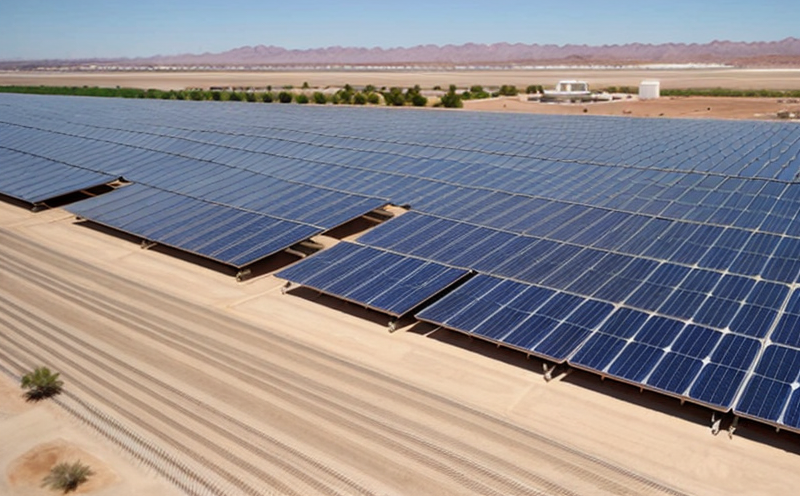EN 12977-4 Heat Exchanger Efficiency Testing
The EN 12977 series of standards is designed to provide comprehensive guidelines for the performance testing of heat exchangers used in solar thermal and concentrated solar power (CSP) systems. Specifically, EN 12977-4 focuses on the efficiency testing of these devices. This standard ensures that heat exchangers meet the necessary performance requirements set by international norms, thereby guaranteeing reliability and safety for end-users.
The scope of this test is to evaluate how effectively a heat exchanger can transfer heat from one fluid to another without compromising on energy efficiency. The process involves subjecting the heat exchanger to controlled conditions that mimic real-world operating scenarios. This ensures that any potential issues are identified early in the development or deployment phase, allowing for timely corrective actions.
The testing procedure outlined in EN 12977-4 includes several key steps: - Preparation of the Test Specimen: The heat exchanger must be prepared according to specific guidelines provided within the standard. This involves cleaning, drying, and ensuring that all components are assembled correctly. - Setting Up the Testing Environment: A controlled environment is created where both inlet and outlet temperatures can be precisely regulated. This setup allows for accurate measurement of heat transfer rates under various conditions. - Data Collection: Temperature sensors and flow meters are used to collect data on fluid temperatures, flow rates, and pressure drops across the heat exchanger. - Analyzing Results: The collected data is then analyzed using statistical methods to determine if the heat exchanger meets the specified efficiency criteria outlined in EN 12977-4.
The importance of this testing cannot be overstated, especially given the critical role that CSP systems play in renewable energy generation. Efficient heat exchangers are essential for maintaining optimal operating temperatures and minimizing losses during the energy conversion process. By adhering to these stringent standards, manufacturers can ensure their products meet high performance expectations while also complying with regulatory requirements.
For quality managers and compliance officers involved in ensuring product integrity across various industries, understanding the nuances of EN 12977-4 is crucial. It provides them with a reliable framework for evaluating heat exchanger efficiency, which directly impacts overall system performance and sustainability goals.
R&D engineers who are working on improving existing designs or developing new technologies will find value in this testing methodology as well. They can use the results to refine their approaches based on real-world data, leading to more robust solutions that better serve end-user needs.
Why It Matters
The efficiency of heat exchangers plays a pivotal role in determining the overall performance and reliability of solar thermal systems. In CSP plants, where high temperatures are crucial for generating steam that drives turbines, any inefficiency can lead to significant losses in energy conversion. Ensuring that these components meet strict standards like EN 12977-4 helps maintain operational efficiency and extends the lifespan of equipment.
Compliance with such international standards also builds trust among stakeholders, including investors, regulatory bodies, and consumers. Demonstrating adherence to recognized best practices not only enhances reputation but also reduces risks associated with non-compliance penalties or market rejection due to poor quality.
From a broader perspective, promoting the use of efficient heat exchangers contributes positively towards global efforts aimed at reducing carbon footprints by leveraging cleaner energy sources. By optimizing each stage of CSP systems through rigorous testing protocols, we contribute to achieving sustainable development objectives outlined in frameworks like the Paris Agreement.
Industry Applications
The application of EN 12977-4 goes beyond just laboratory settings; it extends into practical industrial applications where accurate measurement and reliable performance are paramount. One notable example is its usage in large-scale CSP plants located around the world.
In these facilities, multiple types of heat exchangers are employed to manage vast quantities of hot fluids efficiently. The rigorous testing procedure prescribed by EN 12977-4 ensures that every component functions optimally under extreme conditions, thus enhancing plant productivity and reducing maintenance costs over time.
Another area where this standard finds relevance is in residential solar water heating systems. Here too, efficient heat exchangers play a crucial role by ensuring hot water supply even during cold weather conditions when traditional methods might falter. By adhering to EN 12977-4 guidelines, manufacturers can produce reliable products that meet consumer expectations and regulatory stipulations.
Furthermore, research institutions often utilize this testing method as part of their ongoing efforts to innovate in solar thermal technology. Through continuous refinement based on validated test results, they aim to push boundaries further towards higher efficiencies and lower costs.
Customer Impact and Satisfaction
When customers invest in systems that incorporate heat exchangers tested according to EN 12977-4 standards, they can expect several benefits. Firstly, there's increased assurance regarding product quality and durability since these components have undergone stringent evaluation processes. Secondly, the use of such tested parts ensures consistent performance over extended periods, which translates into lower operational costs for businesses or households.
Additionally, satisfied customers contribute to positive reviews and recommendations, fostering goodwill within communities concerned about environmental sustainability. This aspect is particularly important given the growing awareness about climate change impacts, where responsible purchasing decisions play a vital role in promoting eco-friendly practices.
The confidence that comes with knowing your equipment meets international standards can also lead to enhanced customer satisfaction levels. When consumers feel secure about their investments, they are more likely to recommend these products or services to others, thereby contributing to broader market acceptance and adoption rates for solar thermal technologies.





